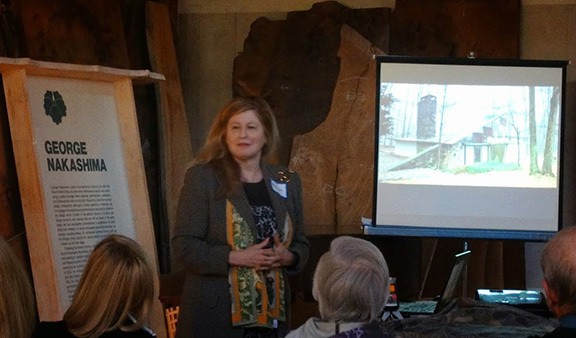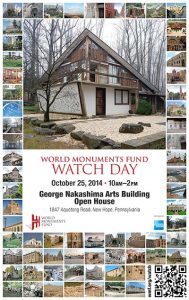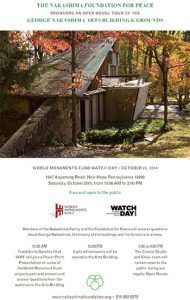Greetings to all.
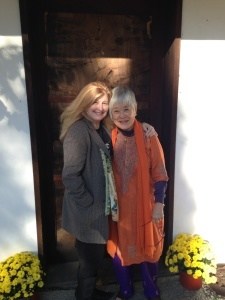
I would like to put into perspective today for Mira chose this very good day months ago to hold the World Monuments Fund Watch Day. Just yesterday was the UN’s 69th birthday and I had the privilege of being in the General Assembly for its birthday as Lang Lang and Sting played. Today is also Global Shabbat Day, an initiative for all to celebrate this holy day of rest and peace.
Thank you Mira for this glorious day as nature also smiles on us!
In the late 1930s George Nakashima was at the Sri Aurobindo Ashram, overseeing the construction of the 1st modern building in India. So moved by the sincerity of the atmosphere and the disciples, he joined the community and was given the name of Sundaranda, which means “one who delights in beauty”, by the great yogi and sage Sri Aurobindo.
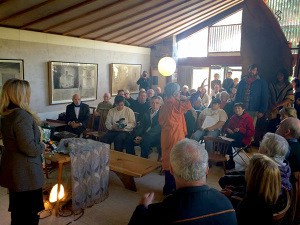
Here we are decades later and Nakashima’s works of beauty have brought delight to millions around the world. He has been honored and awarded many times and we are now happy to celebrate today his inclusion in the World Monuments Fund.
I know the weather is wonderful and the food smells delicious but please sit comfortably with your feet flat on the floor.
We will do just a short meditation. Exhale your distractions. Inhale the light and beauty of this space. If you wish, you may close your eyes to more fully relax into the meditation.
Please see in your mind’s eye all the places that Frank (the US Program director of the WMF) described. These special expressions of humanity’s aspiration for beauty and culture. Let us see this network around the world. Now add to it the legacy of the Nakashima Foundation for Peace: the Altar of Peace in the Cathedral of St. John the Divine in NYC, and the 2 other Sacred Peace Tables – 1 in Auroville, the UNESCO recognized international community in south India, and the other in Moscow.
Combine these all together in a stream of light going in a clock wise direction around our sweet and fragile globe.
Let us uplift these aspirations of humanity’s beauty into an expression for peace and harmony: for peace and harmony between people, between us and nature. Allow this to rejuvenate our delicate climate and to bring it into harmony. Let us each have peace in our bodies as we send this light now from our hearts.
Let us sit in gratitude as we are in this very beautiful space on this gorgeous day. How fortunate we are to be here now!
When you are ready, kindly open your eyes as your continue to do this mindful meditation.
Thank you.
 The Announcement for the Event
The Announcement for the Event
The Nakashima Foundation for Peace and the World Monument Fund will hold a “Watch Day” event on Saturday, October 25, 2014 from 10:00 a.m. – 2:00 p.m. commemorating the Nakashima Foundation’s inclusion on the World Monuments Watch List. The event is free and open to the public.
Launched in 1996 and issued every two years, the World Monuments Watch calls international attention to the challenges facing cultural heritage sites around the globe. Inclusion on the list provides an important opportunity for the Nakashima Foundation for Peace to work towards improved site-protection and to build community engagement in their preservation efforts.
Beginning at 10:00 a.m., members of the Nakashima Family and the Foundation for Peace will answer questions about George Nakashima, the history of the buildings and his furniture business.
At 11:00 a.m., Frank Emile Sanchis III, US Program Director of World Monument Fund will give a presentation on some of the World Monument Fund projects past and present and answer questions from the audience in the Arts Building.
A meditation led by Miriam Belov will conclude this part of the program.
Light refreshments will be served in the Arts Building at 12:00 p.m., followed by a cello concert by Noelle Cassella Grant in the Pool House.
“Watch Day” events will conclude at 2:00 PM. The Conoid Studio and Showroom will remain open to the public during the regular Open House from 1:00 to 4:30 PM:
During the open house, the Nakashima family, woodworking staff and foundation board will be on hand to distribute maps of the property, to guide and to answer questions. Commemorative posters will be available for sale at the Arts Building after the presentation.
 About the Nakashima Foundation for Peace Arts Building
About the Nakashima Foundation for Peace Arts Building
In the 1960s, because of his close friendship with the artist Ben Shahn and ongoing interest in the craft and monastic traditions of the world, George Nakashima designed and built the “Arts Building” with the intent that Ben would be able to display his art. He opened a beautiful show of Ben Shahn’s prints, some in Nakashima frames, in 1967. Ben noticed that there was a perfect wall for a mosaic, designed one of his few abstract compositions for that wall. When Ben passed away in 1969, George and his son, Kevin, took this design to Ben’s mosaicist, Gabriel Loire, in Chartres, France, and had him fabricate the mosaic, ship it in 8 panels, and installed it in 1972 in memory of Ben. The interior wall of the building contains Japanese volcanic rock from the 1964 World’s Fair, a “keyhole” sculpture gifted by Masayuki Nagare, a cantilevered staircase, Nakashima’s framed architectural drawings from the University of Washington and Massachusetts Institute of Technology in 1930, and two Harry Bertoia sculptures gifted by Harry in exchange for furniture.
There are two smaller warped plywood shell Hyperbolic Paraboloid roofs on the Nakashima property built in 1956, and a reinforced concrete church of the same shape in Kyoto, Japan, but these are some of the rare examples of this kind of construction in the world. Graduate students from the University of Pennsylvania Architectural Restoration Department are doing intensive research on the design and construction of the buildings, which will serve as a guide for maintenance and future restoration.
The World Monument Fund will assist in the training of craftsmen and builders to make sure that the restoration work is done with respect for and understanding of the original engineering, materials and techniques used by George Nakashima in the 1960s.
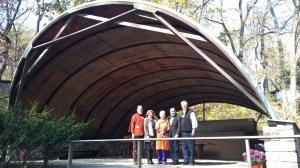
Other important architectural elements are a thin warped plywood barrel vault shell covering the Pool House built in 1960, a reinforced concrete pool with special cantilevered deck, and the Reception House, the last building George Nakashima designed and built in 1975 with a sunken Japanese tile tub and Japanese Tea Room, all of which will be open during Watch Day.

